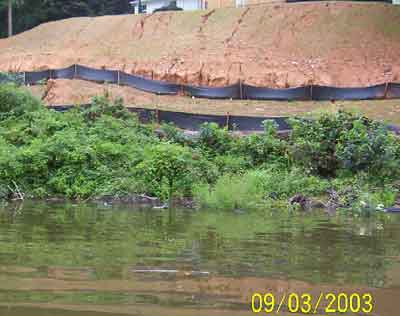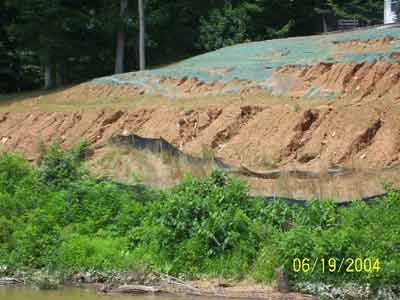Chesapeake Bay Regulations/Resource Protection Areas (RPA's)
Click here to read the Chesapeake Bay Local Assistance Board Resolution
Local Program Compliance Evaluation, Prince William County - Not Fully Compliant
 Prince William is a 'Chesapeake Bay county,' along with all other Virginia localities that have tidal wetlands. Virginia's Bay regulations are mandatory in these areas. Virginia's Chesapeake Bay Local Assistance Dept. (CBLAD) oversees Virginia's program and monitors compliance with the regulations. CBLAD has just completed a compliance review for Prince William and will hold a public hearing on Sept. 20 to finalize their findings.
Prince William is a 'Chesapeake Bay county,' along with all other Virginia localities that have tidal wetlands. Virginia's Bay regulations are mandatory in these areas. Virginia's Chesapeake Bay Local Assistance Dept. (CBLAD) oversees Virginia's program and monitors compliance with the regulations. CBLAD has just completed a compliance review for Prince William and will hold a public hearing on Sept. 20 to finalize their findings.
Although the Chesapeake Bay regulations are Prince William's best available tool to protect trees and stream corridors, the county has regularly interpreted the rules in ways that fall short of the intent. One key problem through the years has been the Preservation Area Site Assessment (PASA), a 'ground-truthing' study that has routinely been used to reduce the number of acres protected by the Chesapeake Bay regulations.
Virginia strengthened the Chesapeake Bay regulations two and a half years ago. The new regulations call for changes to Prince William's 'ground-truthing' process and other revisions. CBLAD granted the regulated localities one year to complete implementation of the changes. During this period, which coincided with a drought, some developers completed the 'ground-truthing' study (PASA) - under the old rules - for many parcels and Prince William agreed to 'grandfather' (vest) these studies.
In spring 2004, we filed a formal complaint with CBLAD using the South Market development project to illustrate Prince William's process. On June 2 CBLAD sent Prince William a formal opinion, approved through the Attorney General's office, determining that Prince William's 'grandfathering' of the 'ground-truthing' studies does not comply with Virginia's regulations.
When Prince William achieves full compliance with Virginia's new Chesapeake Bay rules, we will strengthen our local capacity to protect stream corridors. Right now Prince William appears reluctant to make changes. The County has made no visible moves toward complying with Virginia's regulations, despite the ongoing Zoning Ordinance update and other current changes to planning processes. The Chesapeake Bay Local Assistance Board will review these issues on Sept. 20 as part of their determination of compliance for Prince William.
CBLAD has scheduled a public hearing to finalize Prince William's compliance status on September 20, 2004, 10:00 a.m., at CBLAD headquarters in Richmond. Your comments are important, even if you can't attend in person. We'll be attending the public hearing and will be glad to submit your comments for the public record. For assistance, email us at [email protected] or call Kim Hosen at 703.499.4954.
 |
 |
Virginia's Chesapeake Bay Regulations protect a 100-foot wide corridor along both sides of perennial creeks (year round water flow). This preservation area is intended to protect, or buffer, waterways from the impacts caused by human land uses. The pictures above, taken nine months apart at the same site along the Occoquan River, are one example of Prince William's enforcement shortfalls. More than nine months have passed since Prince William identified the violations (clearing of the 100-foot wide protected buffer) but little has changed. The violations continue to impact the Occoquan River and send a message to local communities that Prince William does not enforce the rules fairly and consistently.
More information on the Chesapeake Bay Local Assistance Department (CBLAD) compliance evaluation of Prince William County's Chesapeake Bay Program:
More information on Prince William County's current Chesapeake Bay policies and regulations:
- Prince William County Five-year Vesting (Grandfathering) Policy
- Letter from Steve Griffin, PWC Planning Director, to the "Development Community" on the Applicability of the Amended Chesapeake Bay Regulations on Development Plans; December 27, 2002
- Prince William County Code, Chapter 32, Article V, Part 504. Chesapeake Bay Preservation Area Overlay District
- Chesapeake Bay Preservation Area Overlay District, Part 504, Changes Proposed for Adoption as part of the Zoning Ordinance Update, scheduled for a Board of Supervisors public hearing on Tuesday, Sept. 21, 2004, 7:30 at McCoart Government Center.
- Resource Management Area (RMA) and Preservation Area Site Assessment (PASA) Minimum Submission Requirements
- Draft Buffer Equivalency - Prince William County Design and Construction Standards Manual: Exhibit 23
- Chesapeake Bay Preservation Area Policy, Planning and Design, and Submission Requirements - PWC Design and Construction Standards Manual, Section 740, 741 and 742
- Congressman Tom Davis Secures $1.2 Million for the Dale Service Corp. to Provide Infrastructure to Meet Effluent Discharge Limits Mandated by the Chesapeake Bay Agreements
- Prince William Approves Stronger Chesapeake Bay Regulations
- Funding Mechanisms for a Watershed Management Program (how Prince William funded the county's Watershed Management Program)
Map of Virginia's Coastal Management Area as defined by the Code of Virginia § 28.2-100 (NOTE: includes Prince William. The only localities required to adopt the Chesapeake Bay regulations are those with tidal wetlands. For example, the City of Manassas and Manassas Park do not have tidal wetlands and are not subject to the Chesapeake Bay regulations.)
News
- WARNER WANTS HELP TO CLEAN BAY; HE URGES OTHER STATES TO SEEK BILLIONS IN AID FROM U.S. GOVERNMENT
Lawrence Latane, Richmond TImes Dispatch; Nov. 5 2004
- WHERE'S THE POLITICAL WILL? BAY-FRIENDLY ORGANIZATIONS AND ANNAPOLIS LAWMAKERS ARE LOOKING OUT FOR THE CHESAPEAKE, RIGHT? THEN WHY ARE CONDITIONS STILL GETTING WORSE INSTEAD OF BETTER?
Bill Thompson, Chesapeake Life Magazine; Nov 2004
- BLAME GAME: The watermen blame the farmers. The farmers blame the poultry growers. The poultry growers blame the sewage treatment plants. And so it goes in the battle to determine who's at fault for the state of the Bay. People around the region speak out on what's crippling the Chesapeake.
Chesapeake Life; Nov 2004
- CHESAPEAKE BAY 'IN PERIL;' RESTORATION OF NATIONAL TREASURE AT RISK
Chesapeake Bay Program Press Release; Oct 27 2004
- BAY PANEL CALLS FOR FUND TO PAY FOR RESTORING ESTUARY; $15 BILLION SOUGHT FROM STATE, FEDERAL LEVELS
Associated Press; Oct 28 2004
- PANEL BRINGS BAY CLEANUP COST INTO FOCUS; $15 BILLION NEEDED TO GET STARTED, GROUP SAYS, BUT FUNDING REMAINS ELUSIVE
David Fahrenthold, Washington Post; Oct 28 2004
- CHESAPEAKE IS IN A RACE AGAINST TIME; RISING SEA LEVELS COULD MEAN DISASTROUS CONSEQUENCES, A FACT THAT HASN'T BEEN LOST ON SOME
Tom Horton, On the Bay, Baltimore Sun; Oct 29 2004
- BAY CLEANUP COSTS COULD TOP $30 BILLION; PANEL TO RECOMMEND WAYS TO PAY FOR ACTIONS THIS MONTH,
Karl Blankenship, Bay Journal; October 2004
- BAY ISSUES RISE TO TOP OF SENATE CONTEST
Gretchen Parker, Associated Press; Oct 22 2004
- BAY IMPACT MURKY
Joseph Cress; The Sentinel; Oct 24 2004
- BASS POPULATION CRASH FEARED; Associated Press; Oct 24 2004
- AMONG CONCERNS OF BAY AREA VOTERS, POLLUTION RANKS NEAR THE TOP, David Fahrenthold, Washington Post; Oct 17 2004
- AT WATER'S EDGE, CREEPING PERIL; STUDY SEES POTENTIAL FOR WIDER FLOOD DAMAGE AS BAY LEVELS RISE, David Farenthold, Washington Post; Oct 13 2004
- MOST VOTERS WILLING TO PAY $50 ANNUAL FEE TO CLEAN UP BAY, Pamela Wood, Annapolis Capital; Oct 12 2004
- GAO to Investigate Whether Bay Cleanup Progress is Overstated; Karl Blankenship, Bay Journal; Sept. 2004
- BAY CLEANUP COSTS TO RISE [ABOVE $3.2 BILLION] , OFFICIALS SAY; AGENCY CHIEF SAYS IT'S NOT CLEAR WHERE MONEY WILL COME FROM,
Lawrence LaTane, Richmond Times Dispatch; Sept 30 2004
- ON THE BAY: KEEPING ALIVE AN ECOSYSTEM,
Tom Horton, Baltimore Sun; August 27 2004
- BAY HAS SERVED AS EAST COAST SEPTIC TANK, A. Barton Hinkle, Richmond Times Dispatch; August 24 2004
Links
- Alliance for the Chesapeake Bay
- Chesapeake Bay Foundation
- CBF Calls on Federal Government to Prevent 10 Bay-Damaging Projects
- #4. Western Bypass, Stafford, Prince William, and Loudoun Counties, VA - This highway will destroy 300 to 450 acres of wetlands and threaten the water supply from Lake Manassas and, indirectly, Occoquan Reservoir. The bypass will also impact 25 major stream crossings, and threatened and endangered species. Indirect impacts include increased sprawl.
- #8. Waterfront Development Plans, Prince William County, VA - The development would cause the loss of several hundred acres of forest, wetland, and stream habitat on Cherry Hill and adjacent peninsulas. Other impacts include innumerable stream crossings, and cut and fill on steep slopes.
- Chesapeake Bay Local Assistance Department (CBLAD)
- Chesapeake Bay Program (Environmental Protection Agency)
- Chesapeake Bay Program (Virginia Department of Environmental Quality)
- Chesapeake Bay Trust
- Code of Virginia - Title 10.1 - CONSERVATION, Chapter 21 - Chesapeake Bay Preservation Act
- EPA's Chesapeake Bay Program Office
- EPA's 2002 National List of Impaired Waters by State
- Fairfax County
- New York and the Chesapeake Bay - Fact Sheet
- Northern Virginia Regional Commission
- Northern Virginia Soil & Water Conservation District
- U.S. Fish and Wildlife Service, Chesapeake Bay Field Office
- US Geological Survey
NOTE: The Chesapeake Bay regulations affect a wide range of land use and water quality issues in Prince William, so see the material on these other issues as well:


 Prince William is a 'Chesapeake Bay county,' along with all other Virginia localities that have tidal wetlands. Virginia's Bay regulations are mandatory in these areas. Virginia's Chesapeake Bay Local Assistance Dept. (CBLAD) oversees Virginia's program and monitors compliance with the regulations. CBLAD has just completed a compliance review for Prince William and will hold a public hearing on Sept. 20 to finalize their findings.
Prince William is a 'Chesapeake Bay county,' along with all other Virginia localities that have tidal wetlands. Virginia's Bay regulations are mandatory in these areas. Virginia's Chesapeake Bay Local Assistance Dept. (CBLAD) oversees Virginia's program and monitors compliance with the regulations. CBLAD has just completed a compliance review for Prince William and will hold a public hearing on Sept. 20 to finalize their findings. 
